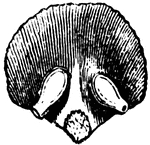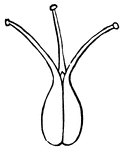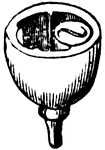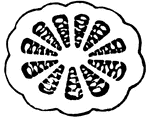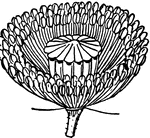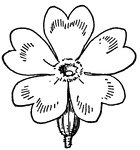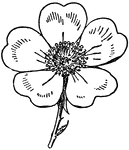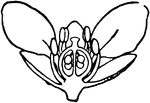The Flower Anatomy ClipArt gallery includes 418 illustrations of the parts of a flower.
Pistil
A simple pistil (of Isopyrm), with ovary cut across; the inner (ventral) face turned toward the eye:…
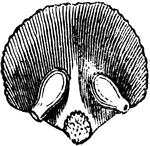
Pistil
A pistil, that is, a scale of the cone, of a Larch, at the time of flowering; inside view, showing its…

Pistil
Pistil of Geranium or Cranesbill, ripe, with the five carpels splitting away from the long beak (carpophore),…
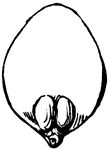
Pistil
The upper side of an open pistil or scale from a forming Larch-cone. The ovules becoming seeds.

Pistil Examples
The pistil is the female or seed-bearing organ of a flower. a, Lilium bulbiferum; b, Geranium sanguineum;…

Pistil from Flower of Pea
Pictured is the pistil from the flower of a pea. A is the pistil from the side, (o) is the ovary, (s)…

Pistil of common St. John's-wort
Compound 3-carpellary pistil of common St. John's-wort, cut across: the three styles separate.
Pistil of Sandwort
Pistil of a Sandwort, with vertical and transverse section of the ovary: free central placenta.

Pistil of Saxifrage
Two simple carpals or pistil-leaves, united at the base only, cut across both above and below.
Pistil of shrubby St. John's-wort
The same of shrubby St. John's-wort; the three styles as well as ovaries here united into one.
Pistil of Spiderwort
Compound 3-carpellary pistil of Tradescantia or Spiderwort; the three stigmas as well as styles and…
Broadleaf Plantain - Spike
Plantago major. "...a flower cluster or form of inflorescence in which the flowers are sessile (or apparently…
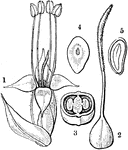
Ribwort Plantain
"Plantago lanceolata. 1. flower and bract; 2. pistil; 3. ovary cut across; 4. seed; 5. section of it."…

Orders of Plantanceae, Rosaceae, and Leguminosae
Pictured are the orders of plantanceae, rosaceae, and leguminosae. The flowers of these orders that…
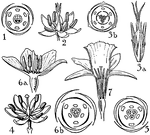
Pontederiaceae, Juncaceae, Liliaceae, and Amaryllidaceae Orders
Shown are flowers of the pontederiaceae, juncaceae, liliaceae, and amaryllidaceae orders. These flowers…
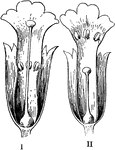
Primrose Flowers
"Dimorphous flowers of the primrose. I, a long-styled flower; II, a short-styled one." -Bergen, 1896

Wingleaf Primrosewillow
"Ludwigia Jussiaeoides. 1. a flower with two sepals and all the petals cut off; 2. a calyx and inferior…

Orders of Rubiaceae and Valerianaceae
Pictured are flowers of the orders rubiaceae and valerianaceae. The flowers pictured are (1) galium,…
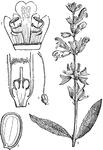
Common Sage
"1. Salva officinalis; 2. its corolla laid open; 3. its pistil; 4. the pistil and lower part of the…

Salicaceae, Myricaceae, Juglandaceae, and Betulaceae Orders
Shown are the orders of Salicaceae, Myricaceae, Juglandaceae, and Betulaceae. Illustrated are various…

Salvertia
"Salvertia convallariodora. 1. an expanded flower; 2. a portion of the calyx, with the stamens; 3. a…
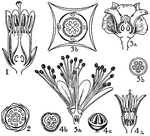
Orders of Sapotaceae, Ebenaceae, Styracaceae, and Symplocaceae
Pictured are flowers of the orders sapotaceae, ebenaceae, styracaceae, and symplocaceae. The flowers…
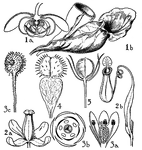
Orders of Sarraceniaceae, Nepenthaceae, and Droseraceae
The orders pictured are sarraceniaceae, nepenthaceae, and droseraceae. The flowers of these orders that…

Section of Flax-flower
Section of a flower moderately enlarged, showing a part of the petals and stamens, all five styles,…

Sedum Ternatum
Parts of the same, two of each kind, separated and displayed; the torus or receptacle in the centre;…

Selago
"Selago distans. 1. a flower; 2. an anther; 3. a perpendicular section of an ovary; 4. section of seed…

Disk-floret of the Senecio (Longitudinal Section)
An longitudinal section view of a disk-floret of the senecio flower. Senecio is a genus of the daisy…

Female ray-floret of the Senecio
An illustration of a ray-floret of the senecio flower. Senecio is a genus of the daisy family (Asteraceae)…
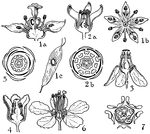
Orders of Simarubaceae, Burseraceae, Meliaceae, and Malpighiaceae
The orders of simarubaceae, burseraceae, meliaceae, and malpighiaceae are pictured. The flowers of these…
Simple Pistil
Model of a simple pistil, with ovary cut across and slightly opened ventrally, to show the ovules and…

Single Fruit
Composite, or compound flower, from one of the largest botanical orders. 4, single fruit.
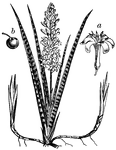
Snake Plant
Sansevieria Zeylanica is the Latin name, but this plant is also called a Mother-in-law's Tongue. "A…
Seneca Snakeroot - Stem and Flowers
"Polygala senega of eastern North America. It sends up several stems from hard knotty root-stocks, bearing…
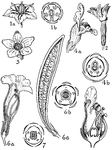
Orders of Solanaceae, Scrophylariaceae, Bignoniaceae, and Pedaliaceae.
Pictured are flowers of the orders solanaceae, scrophulariaceae, bignoiaceae, and pedaliaceae. The flowers…

Spearmint Flower
"An aromatic plant, Mentha viridis, the common garden-mint, or mint proper. It is known chiefly in gardens,…
